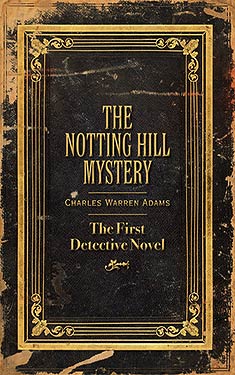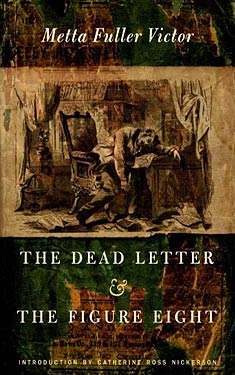The Old Weird: Occult Detectives 1: The Notting Hill Mystery and The Dead Letter
Rhonda Knight is a frequent contributor to WWEnd through her many reviews and her excellent blog series Automata 101 and Outside the Norm. Ronda is an Associate Professor of English at Coker College in Hartsville, SC. She teaches Medieval and Renaissance literature as well as composition courses.
Each of these books is attributed to a pseudonym, but that is not all they have a lot in common. The Notting Hill Mystery by Charles Felix (probably the pseudonym of Charles Warren Adams) and The Dead Letter by Seeley Regester (the pseudonym of Metta Victoria Fuller Victor) also feature occult detectives. In addition, each book is purported to be the first detective novel written in England and America, respectively. Of course, Edgar Allen Poe is the progenitor of the mystery story, creating detective C. Auguste Dupin in 1841, and Wilkie Collins is considered the creator of the mystery novel, publishing The Woman in White in 1860, but it does not feature a detective as such. Collin’s later novel The Moonstone (1868) contains a good example of the first amateur detective. Charles Felix’s The Notting Hill Mystery,serialized from Nov. 29, 1862 to Jan. 17, 1863 in Once a Week, was published as a novel in 1863. In 2010, Paul Collins wrote an article about The Notting Hill Mystery for the New York Times revealing that Charles Felix was the pen name of the lawyer Adams and that this serial detective novel predates Wilkie Collins’ The Moonstone by five years. In America, Anna Katharine Green’s The Levenworth Case (1878) is usually named the first American detective novel, but The Dead Letter, serialized in Beadle’s Magazine from Jan. to Sept. 1866 and published as a novel the following year, predates it by several years. I will leave it to other critics to debate which novel is the first in its genre. What is important to me is these novels are early cases that combine detective fiction and the weird. Each focuses on paranormal mental capabilities. Mesmerism plays a large role in The Notting Hill Mystery, and one character’s psychic abilities aid the detective in The Dead Letter.
Felix’s novel seems very contemporary in its presentation. A modern author of Victorian period detective stories, like Anne Perry, could have been written it. The detective in this case is Ralph Henderson, an insurance investigator, looking into the death of Madame R**. Her husband insured her life for 5000£, the maximum allowed by his company. Henderson discovers that the husband has four more policies with other companies, totaling 25,000£. The novel takes the form of his report and is told through a series of memoranda to his employers. Each memorandum contains a wealth of supporting documents–letters, witness statements, scraps of paper evidence, diagrams, and other interesting devices, such as footnotes that Henderson writes to refer the readers to earlier pieces of evidence. The husband, Baron R**, is a mesmerist, a doctor, and an amateur chemist. In his documents, Henderson follows Baron R**’s treatment of the sicklyMrs. Anderton. Baron R** also treats his wife when she becomes ill. What surprised me about this early mystery handles the expected tropes of detective fiction very well. Henderson amasses a lot of forensic evidence and makes logical deductions based on time tables, alibis, and diagrams. Henderson has no particular belief in the occult; however, his conclusions depend his analysis of so many coincidences that he can only come to one solution. Just like Sherlock Holmes will say a few years after this Notting Hill’s publication: “When you have eliminated all which is impossible, then whatever remains, however improbable, must be the truth” (The Blanched Soldier).
The instances of the occult in The Notting Hill Mystery do not appear in order to scare the reader. Rather, the book fits into the growing Victorian interest in the paranormal. In the Introduction to Heartbreak House (1919), George Bernard Shaw characterizes the era as “addicted to table-rapping, materialization, séances, clairvoyance, palmistry, crystal-gazing and the like to such an extent that it may be doubted whether ever before in the history of the world did soothsayers, astrologers, and unregistered therapeutic specialists of all sorts flourish as they did during this half century of the drift to the abyss. The registered doctors and surgeons were hard put to it to compete with the unregistered.”
I recommend this book, not just as an early example of the occult detective but as an interesting and worthwhile adventure. It does not seem dated at all in presentation and just a little bit dated in language. There are several cheap or free ways to get this book. You may read it for free in its original serialized form in Once a Week if you go to the book’s Wikipedia page and follow the links to each of the eight sections. Another way to read the book for free is to download a copy from Google Books. However, I do not recommend this edition. The scanning is particularly bad, and the OCR artifacts were never corrected. This means there are some unreadable sentences. In addition, the editor did not know how to handle Felix’s use of footnotes; therefore, they appear in unlikely (and unhelpful) places. Instead, I highly recommend the Audiobooks edition (no, it is a ebook, not an audiobook) for $2.99 available in iBooks and Kindle formats. The book contains updated drawings modeled after the ones contained in the serial and first book printing, but it also contains an appendix that shows the original drawings from Once a Week. The footnotes and images are handled well. I noticed about ten typos, but otherwise the text is very readable.
Regester’s novel seemed more dated in style and language than The Notting Hill Mystery. This book is narrated in the first person by Richard Redfield, an employee in a dead letter office. He opens a two-year-old letter that seems to confirm that a murder-for-hire had been committed in Blankville, NY eighteen months earlier. Renfield’s friend, Henry Moreland, was murdered in the town on the day before the letter was posted. The grief over the unsolved murder destroyed the family of Eleanor Argyll whom Moreland was to marry. The first part of the book is told in flashback by Redfield in his role as an Argyll family friend. He narrates the unsuccessful investigation by the police and Mr. Burton, an amateur who has helped the New York City police on many occasions. Redfield says that Mr. Burton “was intelligent, even educated, a gentleman in language and manner—a quite different person, in fact, from what I had expected in a member of the detective-police” (60). Burton displays some “rare powers” of detection, based in clairvoyance (69). His eleven-year-old daughter, Lenore, is a very powerful clairvoyant, and he uses her talents when his efforts are not enough. For example, in one instance, Burton uses mesmerism to put Lenore to sleep and then hands her an object dropped by a suspect. Lenore is able to see and describe the room the suspect lives in. Burton is able to instruct her to leave the imaginary room, walk down the street and read the house number and street sign (102-04). Regester constructs the mystery in a way that Lenore is not overly used, which would take the fun out of the mystery.
Part Two opens with Redfield bringing the dead letter he discovered to Burton. It is too old for Lenore to get many emanations from it. However, Burton suddenly becomes very much like Sherlock Holmes and C. Auguste Dupin. He displays his hidden talent to tell Redfield much about the writer of the letter. Instead of the abductive reasoning that Dupin and Holmes use to shock their narrators and clients, Burton uses his knowledge of handwriting to give Redfield the vital statistics of the murderer. He says “you are not aware of my accomplishment in the art of reading men and women from a specimen of their handwriting. It is one of my greatest aids in the profession to which I have devoted myself” (206).
In Part Two, Burton and Redfield travel to California in search of the murderer. I found it very interesting that in 1868, the preferred journey to California from New York was by boat. Of course, this is long before the Panama Canal was even started. The discovery of gold in California had prompted a rail line across the isthmus, so passengers traveled by boat to and from the isthmus and by train across it. Our detectives unravel the mystery and restore order to Blankville.
There is a recent university press copy (paperback, Kindle, Nook) of this book available. It is paired with another novel, The Figure Eight, also by Metta Victor. Most of the free copies that I’ve found are flawed in some way. The Internet Archive has e-texts in several forms; however, the epub version is unreadable because of OCR artifacts. The Black and White PDF has pages 19 and 273 missing and the Color PDF has page 25 missing. I read the text online via the HathiTrust site. This is the same copy from the Internet Archive—it has the same graffiti on the same pages. That copy was very readable.
While Henderson’s unraveling of The Notting Hill Mystery was a fun read, Burton felt the most real of the two characters. One could imagine Burton’s other cases. At one point Burton tells Redfield: “I lead a charmed life. Malice and revenge have followed me in a hundred disguises—six time I have escaped poisoned food prepared for me; several times infernal machines, packed to resemble elegant presents, have been sent to me; thrice I have turned upon the assassin, whose arm was raised to strike—but I have come unscathed out of all danger, to quietly pursue the path to which a vivid sense of duty calls me” (250). If Metta Fuller Victor lived today, The Dead Letter would be the first in a series of Burton novels. She would have had a three-book deal for certain. Unfortunately, we get only one.
Next Up—Joseph Sheridan Le Fanu’s Dr. Martin Hesselius in In a Glass Darkly.



















 Full Details
Full Details





No comments yet.
Sorry, the comment form is closed at this time.